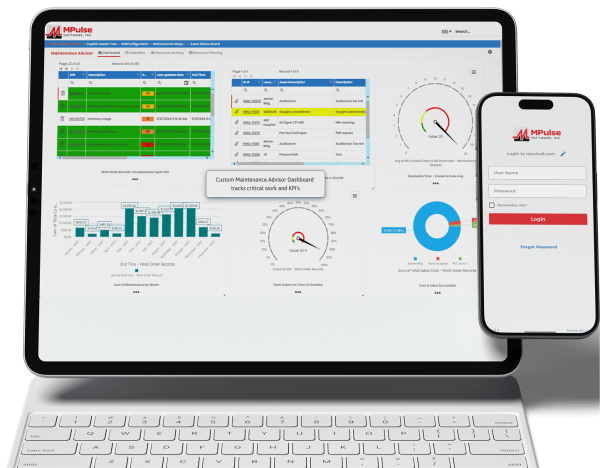Maintenance plays a major role in keeping healthcare facilities running smoothly. It’s a challenging task. These organizations juggle the needs of patients and providers, while complying with related legislation and regulations.
Typical maintenance needs can range from facility HVAC systems and generators to equipment to electrical and plumbing repair to cleaning supplies. Additionally, the type of assets found in healthcare facilities is vast. From clinics to hospitals to laboratories to residential care, these organizations use specialized assets and facilities that require ongoing maintenance services—including life-saving equipment, offices, residential units, and outdoor space.
As a result, organizations need the right tools to manage maintenance for all these assets, whether it’s repairing a critical piece of equipment or replacing a light bulb. CMMS software for healthcare excels at tracking the details of your increasingly complex healthcare operations.
Healthcare facilities often identify at least one of these seven reasons for implementing a CMMS.
Table of Contents
Reason #1: Compliance
Healthcare facilities must maintain compliance with numerous regulatory agencies. CMMS software can help by providing a reliable central repository for your maintenance and safety data. It collates all the vital information and generates accurate reports for audits.
Healthcare CMMS software is designed specifically for maintenance, thereby enabling you to safely store all the required PM schedules, equipment records, and asset data. That information provides the basis for any reporting needed for regulatory audits or inspections. Yet since CMMS solutions don’t track patient information, they aren’t held to the same level of security as other software used by healthcare facilities, such as CRM or ERP programs.
Reason #2: Preventive Maintenance
When a maintenance team establishes and regularly performs PM tasks that contribute to the upkeep of assets, an organization may be able to sidestep serious problems that arise as a result of neglect, as well as delay more expensive maintenance. For example, medical equipment requires periodic inspections to ensure that it’s working correctly. Healthcare CMMS programs ensure equipment is properly calibrated and lubricated, and maintenance tasks are performed in a timely manner.
Automating preventive maintenance with CMMS software helps maintenance teams schedule PM tasks, making it simpler to follow the manufacturer’s guidelines. Maintenance intervals can be scheduled based on time, operating hours, or part condition—triggering a work order just before the point when system inefficiencies or failures begin to occur. Over time CMMS creates historical data for the asset, which maintenance managers can use to determine if repairs were successful or if they need to adjust the PM schedule based on performance.
Reason #3: Condition-Based Maintenance
Condition-based maintenance (CBM) keeps tabs on the actual state of your critical assets by recording the output of any meters and gauges on that asset. When an asset’s condition changes outside of specified ranges, a trigger lets you know immediately so you can react to prevent breakdowns before they happen.
CBM may apply to the maintenance of high-risk medical equipment. That includes all life support equipment and any other device for which there is a risk of serious injury or death to a patient or staff member should it fail. Maintenance activities and frequencies should follow manufacturers’ instructions and recommendations for maintaining, inspecting, and testing all medical equipment.
Reason #4: Fewer Breakdowns
CMMS software can help you reduce emergency maintenance issues and unexpected downtime. This, in turn, cuts overtime costs for emergency repairs. For example, inspections need to occur at specific time intervals to help maintenance teams spot issues before they occur. Common time triggers include items like fire alarms, elevators, and seasonal facility equipment (i.e., HVAC units).
You also can use CMMS to trigger maintenance tasks using a specific meter. You can choose meters like mileage, usage time, production volume, pressure, flow rate, etc. Over time these repairs create historical data for the asset. Then, maintenance managers can determine if repairs were successful or if they should adjust the PM schedule based on performance. For example, if an asset breaks roughly every 1,000 hours of usage time, set your trigger for 900 hours.
Reason #5: Documentation
Healthcare facility maintenance requires documentation, which CMMS can automate. Once it’s set up, your maintenance team is ready to go. Your maintenance technicians have custom checklists, resources like repair and preventative maintenance manuals, asset history, and safety procedures right there with the work order.
Inconsistent record-keeping procedures are a common cause of regulatory agency citations and fines. CMMS data provides both the big picture and the little details, so your maintenance tasks are both visible and verifiable. Much of that documentation is also automated with each completed work order. And best of all, you can access the information in minutes, instead of spending hours or even days sorting through a paper filing system.
Reason #6: Safety
Safety in the workplace affects everyone. CMMS helps healthcare organizations improve safety policies with updated safety procedures, documented safety training, employee reminders, standardized checklists for scheduled inspections, paper trails showing preventive measures, and detailed emergency procedures in case of a natural disaster or other incidents.
A proactive safety initiative supported by consistent documentation particularly serves its purpose during an emergency. Such an event can trigger related tasks such as conducting inspections; implementing safety measures; managing resources, supplies, and personnel; gathering data for insurance purposes, etc.
Reason #7: Key Performance Indicators
CMMS software uses the data gathered in every work order to create meaningful KPIs that tell you about the effectiveness of your maintenance strategies. While every organization is different, maintenance KPIs that most MPulse customers find helpful to monitor include…
- Planned Maintenance Percentage: the percentage of the total hours spent on PM maintenance activities over a specific period.
- Preventative Maintenance Compliance (PMC): the percentage of scheduled PM tasks that get done in a specific time interval.
- Mean Time to Repair (MTTR): the average time to evaluate and repair failed equipment.
- Mean Time Between Failures (MTBF): the predicted time between failures of an asset during normal operation.
- Overall Equipment Effectiveness (OEE): the percentage of time that an asset is truly productive.
- Maintenance Backlog: the percentage of uncompleted tasks.
- Annual Cost of Operation: the total costs associated with the day-to-day operation of a facility.
- Current Replacement Value: the total amount of expenditure in current dollars required to replace the organization’s facilities to its optimal condition.
- Deferred Maintenance: the total dollar amount of existing major maintenance repairs and replacements identified by a comprehensive facilities condition audit.
- Facility Operating Current Replacement Value (CRV) Index: the level of funding provided for the stewardship responsibility of an organization’s capital assets.
- Full-time Equivalent: a measurement that standardizes the mix of part-time and full-time employees within a fiscal year.
- Energy Usage: the amount and cost of energy used in a specific time period.
MPulse meets the needs of hospitals and healthcare organizations of all sizes. We provide affordable solutions and exceptional customer support to help companies with the complex maintenance requirements in all healthcare-related industries—including hospitals, medical offices, pharmaceutical companies, medical device manufacturers, biotech developers, and more.
Learn how MPulse can help your maintenance team promote and maintain compliance, while also reducing emergency maintenance issues and unexpected downtime. Contact us for more information. We’re here for you.






